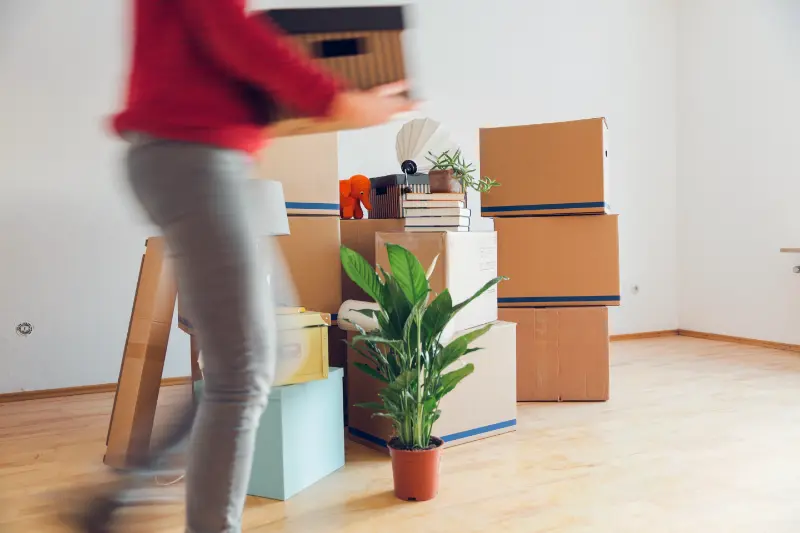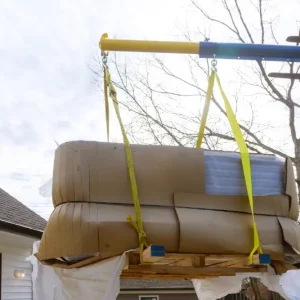Facing a house full of items to pack for your upcoming move? Streamline your moving process with essential tips on how to pack up a house to move, ensuring nothing is left to chance. Forget about the overwhelm; this article walks you through clear, actionable steps, from drafting a moving checklist to handling delicate heirlooms with care. Ready to move smartly and stress-free? Let’s get you from packed-up to set-up with ease.

Key Takeaways
- Start moving prep early with a clear plan, including a timeline and budgeting, and decide whether to DIY or hire pros like Horizon Movers.
- Accumulate the right supplies, like boxes and protective materials, and take care when securing and labeling items to ensure they arrive safely.
- Pack room by room, handle fragile and valuable items with extra care and stay organized to maximize efficiency on moving day.
The Power of Preparation
You’ve likely heard the saying, “Preparation is key,” often. In the context of moving, this adage holds significant truth. Reducing stress and making the process smoother is all about preparation. Think of it as a journey. You wouldn’t set out on a road trip without a map or a GPS, would you? The same principle applies to moving.
What if I told you that with a bit of preparation, you could save time and money? That’s right! Planning ahead and utilizing moving hacks could simplify the process and significantly cut costs. Are you geared up to pack like an expert?
Moving Plan
Consider the difficulty of solving a puzzle without the picture on the box. That’s the equivalent of attempting to move without a plan. A moving plan is essentially your roadmap, guiding you through each step of the moving process.
Start by mapping out a timeline. Believe me, there’s usually more to pack than you anticipate, making an early start essential. Break down the task room by room to clarify what you need to move and what you can leave behind. And don’t forget about logistics. Knowing who’s doing what and when can save you a lot of headaches down the line.
Budgeting
Addressing the unavoidable fact: moving can be pretty costly. But with a bit of savvy budgeting, it doesn’t have to be. Online calculators are your best friend when it comes to figuring out your expenses.
And remember, every little bit counts. Even choosing to move in the middle of the week or month can lead to significant savings. Also, consider the cost-effectiveness of moving certain items. For instance, is it really worth it to haul all those heavy cans of soup across the country?
DIY vs. Professional Help
The dilemma often arises – should you DIY or not? While doing it yourself might seem like the cheaper option, it’s not always the case. Consider the time, effort, and potential for mistakes.
On the other hand, hiring professional help like Horizon Movers and Climate Control Storage can take a lot of the stress off your shoulders. Their services include:
- Local and long-distance moving
- Climate-controlled storage
- Junk removal
- Packing services
Furthermore, their family-like approach to moving ensures they handle your belongings with the utmost care.
Gathering Essential Packing Supplies
With the planning taken care of, we can proceed to the next step: amassing supplies. Here is where the excitement kicks in! It feels like embarking on a treasure hunt, except you’re searching for packing supplies instead of gold.
The basics include:
- boxes
- packing tape
- scissors
- packing paper
- bubble wrap
- markers
- paper towels
- old towels
- blankets

And don’t forget the color-coded stickers! They can be a real lifesaver when it comes to keeping your color code boxes organized.
Types of Moving Boxes
Starting with the fundamental packing supply: packing boxes. Just like every superhero needs their sidekick, every mover needs their boxes. But not all boxes are created equal. Different sizes and types serve various purposes.
Small boxes are best for heavy items like books and kitchenware. Medium ones are versatile and suitable for a variety of items. Reserve large boxes for lightweight items. And for hanging clothes, nothing beats a wardrobe box.
Protective Materials
Moving on to the subsequent feature of our packing supply arsenal: protective materials. Think of them as your belongings’ personal bodyguards, keeping them safe and secure during the move.
For instance, you can use bubble wrap to protect artwork and plastic wrap alongside parchment paper to safeguard framed paintings. And don’t forget about insulated foam containers for refrigerated or frozen items.
Securing Items
With our boxes and protective materials ready, we can now focus on securing our items. This step is where the magic happens. Imagine opening your boxes at your new home and finding everything in perfect condition, just as you left it. That’s the power of proper securing.
Label your boxes with the name of the destined room or a clear description of the contents to make unpacking a breeze. And for small items like hardware, use sealable plastic bags and ensure they’re clearly labeled.
Room-by-Room Packing Guide
The task of packing can seem daunting, particularly when faced with a house filled with belongings. But don’t panic. Breaking it down room by room makes the task more manageable and efficient.
Visualize it as if you’re solving a jigsaw puzzle. You wouldn’t try to combine all the pieces at once, would you? The same principle applies to packing. Start packing by focusing on one room at a time, and before you know it, you’ll be packed up and ready to go!
Bedrooms
The first step is to declutter, beginning with the bedrooms. Discard clothes and personal items you haven’t used in the past year.
Next, pack non-essential items like out-of-season clothing and extra linens. Remember to wash linens before packing to prevent discoloration and odors. For shoes, individually wrap them and pack socks inside to maintain their shape.
Kitchen
Packing the kitchen can be among the most intimidating tasks. But with a systematic approach, it doesn’t have to be. Begin with less frequently used items and keep essentials accessible until you need them in the new home.
When packing fragile items like glassware and dishes, wrap them individually in packing paper and pack them vertically to save space. Also, remember to protect large appliances by readying them for the move 24 hours in advance.
Living Spaces
Moving on to the living areas, wrap large items like furniture, mirrors, and electronics in moving blankets to protect them during the move.
To avoid confusion during unpacking, label all boxes clearly with their contents and destination room. Trust me, your future self will thank you!
Special Considerations for Fragile and Valuable Items
Packing demands a delicate balance, particularly when handling fragile and valuable items. These items require a little extra TLC during the packing process, making the use of fragile boxes and appropriate packing materials essential.
Handle items like fine china or your grandma’s antique vase with care. You can ensure they arrive at your new home safely and sound with the proper packing techniques.
Artwork
Packing artwork can pose specific challenges. However, telescope boxes and the proper wrapping techniques can protect your precious pieces from damage.
Remember to wrap oil paintings in non-acidic paper and apply an X with masking tape across the glass for added strength. It’s all about taking the necessary precautions to preserve the integrity of your artwork.
Antiques and Heirlooms
Given the special place that antiques and heirlooms hold in our hearts, it’s understandable that we wish to safeguard them during relocation. Wooden crates provide the perfect protection for large, valuable items like sculptures or antiques.
But it’s not just about physical protection. Carefully wrapping and securing antiques helps preserve their condition and value for future generations.
Valuable Electronics
Packing valuable electronics can often be troublesome. But you can keep your tech safe and secure with a detailed inventory list and protective materials.
If you have the original packaging, use it. The design protects the item during transit. If not, consider using moving blankets or bubble wrap as a good alternative.
Maximizing Efficiency on Moving Day
We’ve finally reached moving day! All your preparation has paid off. With clear communication with your movers and a well-organized plan, you can make the most of the day.
Being present on moving day allows you to oversee the movers and communicate any last-minute instructions. And remember, color-coding your boxes can expedite the moving process.
Working with Professionals
Collaborating with professional movers such as Horizon Movers and Climate Control Storage can significantly ease the moving day proceedings. With their expert knowledge and over 20 years of experience, they can easily handle your move.
Not only does this moving company offer a range of services, but they also take a family-like approach to moving, treating your belongings as if they were their own. So, you can rest easy knowing your move is in good hands.
Loading the Truck
Filling up the moving truck can feel like playing Tetris, as you need to fit all your items in the most efficient way possible while minimizing empty spaces.
Start with the most significant and heaviest items, placing them towards the front of the truck and against the walls to distribute the weight evenly. Remember to secure each tier with moving straps.
Staying Organized
Bear in mind that maintaining organization on moving days is vital. A digital inventory list can help you keep track of your items and their condition.
For small hardware items, use sealable plastic bags and label them clearly. Take pictures of your boxed items before sealing the boxes with plastic bags for a visual record.
Last-Minute Packing Tips
Finally, if you’re someone who tends to pack at the last minute, don’t worry—we have tips for you, too. Getting assistance from friends and family can significantly accelerate the packing process.
And remember, even in the eleventh hour, prioritizing your packing can make a big difference. Keep essentials easily accessible, and consider hosting a packing party to multiply your efforts.
Summary
And there you have it—a streamlined strategy for packing up your house efficiently and stress-free. With proper planning, the right supplies, a room-by-room approach, and special care for your valuable items, moving doesn’t have to be daunting. So, are you ready to make your next move your best move?
Frequently Asked Questions
How can I save money on my move?
Plan ahead and use moving hacks to save time and money. Moving in the middle of the week or month can lead to significant savings.
What kind of boxes should I use for packing?
You should use small boxes for heavy items, medium for versatile purposes, and large boxes for lightweight items. It’s essential to match the box size with the weight of the items you’re packing.
How should I pack fragile items like artwork and antiques?
Use telescope boxes and proper wrapping techniques when packing fragile items like artwork. For antiques, wooden crates offer the ideal protection.
What should I do on moving day to ensure efficiency?
To ensure efficiency on a moving day, communicate clearly with your movers, have a well-organized plan, and be physically present to oversee and communicate any last-minute instructions. Following these steps will help maximize the efficiency of the move.
What are some last-minute packing tips?
Get your friends and family to help you pack, and consider hosting a packing party to speed up the process. It’s a fun way to make sure everything gets done!




